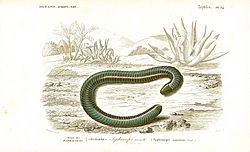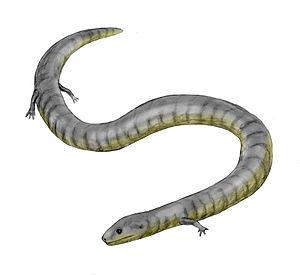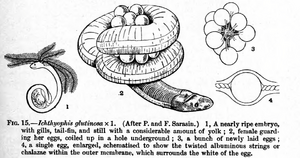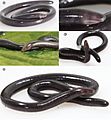Caecilian facts for kids
Quick facts for kids CaeciliansTemporal range: Jurassic – Recent
|
|
|---|---|
 |
|
| "Caecilian" | |
| Scientific classification | |
| Kingdom: | |
| Phylum: | |
| Class: | |
| Order: |
Gymnophiona
Müller, 1832
|
 |
|

Caecilians are a special group of amphibians. They often look like big earthworms or small snakes. Most of them live by burrowing in the ground. Because they hide underground, scientists don't know as much about them as other amphibians.
Contents
Body Features
Caecilians do not have any limbs, like arms or legs. This is why smaller caecilians look like worms, and larger ones, which can grow up to 1.5 meters (about 5 feet) long, look like snakes. They have a short tail, and their cloaca (a body opening) is close to the end of their body.
Their skin is smooth and usually dark. Some species have bright, colorful skin! Hidden inside their skin are small, hard calcite scales.
Because they live underground, their eyes are very small. Often, skin covers their eyes to protect them. This made people think they were blind, but they are not. They can still tell the difference between light and dark.
All caecilians have two special tentacles on their head. These tentacles probably help them "smell" their surroundings in a different way than their nose does.
Breathing
Most caecilians have lungs, just like humans. However, there are two species that do not have lungs at all! Caecilians with lungs can also breathe through their skin or by taking in oxygen through their mouth.
Often, one lung is much smaller than the other. This helps them fit their long, thin body shape, similar to how snakes are built.
Where Caecilians Live
Caecilians mostly live in warm, wet places in South and Central America, Africa, and South Asia. They prefer moist, low-lying habitats.
In South America, you can find them quite far south, even near Buenos Aires, Argentina. They sometimes get carried there by floodwaters from the Paraná River. Scientists haven't studied them much in central Africa, but it's likely they live in the tropical rainforests there.
The species Ichthyophis sikkimensis lives the farthest north, in Northern India. In Africa, caecilians are found from Guinea Bissau down to Northern Zambia. They are not found in Australia or the islands between South-East Asia and Australia. Some species, like Ichthyophis, are also found in South China and North-Vietnam.
Reproduction and Life Cycle
Caecilians are the only group of amphibians that only use internal fertilization. This means the male fertilizes the female's eggs inside her body.
About 25% of caecilian species are egg-laying. The mother guards these eggs. The other species are ovoviviparous, which means the eggs hatch inside the mother's body.
For some species, the young caecilians are already fully grown (metamorphosed) when they hatch or are born. Other species hatch as larvae. These larvae don't live completely in water, but they spend their days in the soil near water.
Feeding Young
In species where eggs hatch inside the mother, the baby caecilians (called fetuses) eat special cells from the mother's oviduct (the tube where eggs develop). They have special scraping teeth to do this. Some larvae, like those of Typhlonectes, are born with very large external gills that they shed almost right away.
The egg-laying species Boulengerula taitanus feeds its young in a very unique way. The mother grows a special outer layer of skin that is thick and full of fat and nutrients. Her babies then use similar teeth to peel off and eat this skin! The species Ichthyophis is known for mothers taking care of their eggs.
What Caecilians Eat
Scientists don't know a lot about what caecilians eat in the wild. It seems they mostly eat insects and other small creatures without backbones (invertebrates) that live in their habitat.
For example, when scientists looked at the stomach contents of 14 Afrocaecilia taitana caecilians, they found mostly organic material and plant bits. But when they could identify specific remains, they were mostly termite heads.
In captivity, caecilians are easily fed earthworms. Earthworms are also very common in the natural homes of many caecilian species.
The Name "Caecilian"
The name Caecilian comes from the Latin word caecus, which means "blind." This refers to their small or sometimes hidden eyes. The name was first used by Carl Linnaeus for the species Caecilia tentaculata.
The scientific name for their order, Gymnophiona, comes from two Greek words: gymnos (meaning "naked") and ophis (meaning "snake"). This is because caecilians were originally thought to be related to snakes.
Caecilian Families

Caecilians are divided into ten main families. The number of species in each family is an estimate, and many species have only been identified from a single specimen. It's likely that more species are still waiting to be discovered, and some species currently listed separately might be grouped together in the future.
- Beaked Caecilians (Rhinatrematidae) – 2 groups (genera), 9 species
- Fish Caecilians (Ichthyophiidae) – 2 groups (genera), 39 species
- Indian Caecilians (Uraeotyphlidae) – 1 group (genus), 5 species
- Tropical Caecilians (Scolecomorphidae) – 2 groups (genera), 6 species
- Aquatic Caecilians (Typhlonectidae) – 5 groups (genera), 13 species
- Common Caecilians (Caeciliidae) – 26 groups (genera), 99 species
A new tenth family was recently discovered in north-east India.
Recent Discoveries
A scientist named Daniel Hofer recently found that some caecilians produce strong skin poisons from special glands. This poison helps protect them from predators. For example, the poison from the bright yellow caecilian of São Tomé Island (Schistometopum thomense) in West Africa can kill other animals kept in the same tank within a few days. Scientists are still studying what chemicals are in caecilian poison.
Another scientist, Werner Himstedt, showed that the skin glands of Ichthyophis caecilians protect their eggs from germs and fungi. It has also been shown that these poisons are very different from those found in other amphibians, like the arrow poison frogs.
The babies of the egg-laying East African Boulengerula taitanus have special teeth that let them peel off and eat their mother's skin. The mother's skin in this species was found to be thicker than normal and contained a lot of fat and other nutrients for her young.
Images for kids
See also
 In Spanish: Cecilias para niños
In Spanish: Cecilias para niños



